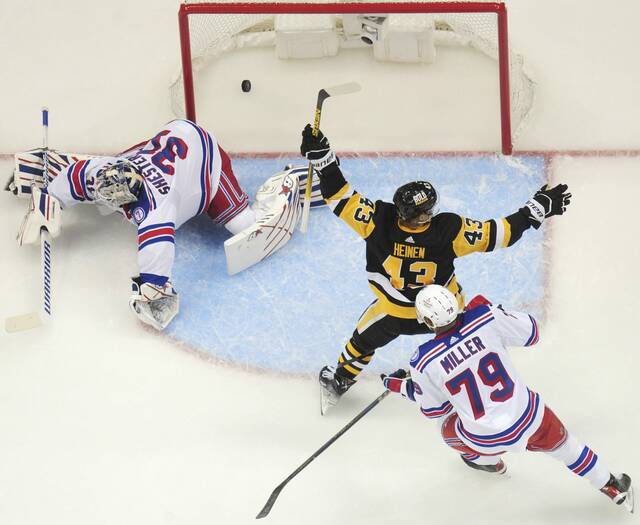Tim Benz: Penguins' spike in goals is impressive, but the work to create the shots is what shines
When it comes to the Pittsburgh Penguins’ goal explosion against the New York Rangers, the contrast is stark between what the Pens did in Games 1 and 2 at Madison Square Garden versus their output at home.
Over the first two games at MSG, the two teams played a little bit more than eight periods of hockey, and the Penguins managed just six goals against New York.
In Games 3 and 4 at PPG Paints Arena, the Penguins rang up 14 goals in six periods of play.
Twelve of those 14 goals were against presumptive Vezina Trophy-winning goaltender Igor Shesterkin, who was benched after the first period in Game 3 and after the second period in Game 4.
For Sidney Crosby, the increase in goal scoring is simple to explain.
“We are going to the front of the net. Some great tips. Sometimes they don’t always go in,” Crosby said of Monday’s 7-2 victory in Game 4. “It’s just guys getting pucks through and guys getting to the front of the net.”
But for as eye-catching as back-to-back games with touchdowns on a hockey scoreboard may be, in a way, it’s the raw shot total that has been more impressive.
Part of the reason that many Penguins fans and media members were pessimistic about the team’s chances of pulling off an upset against the Rangers is that the scoring chances were so infrequent against Shesterkin during the regular season. Forget scoring goals against a netminder as good as Shesterkin, the Penguins rarely even threatened.
Coach Mike Sullivan’s team only got four goals in four regular-season games against Shesterkin for reasons beyond the young Russian’s notable skill. Sullivan’s players weren’t even getting shots on goal. The Penguins only totaled 101 of them in four games. An average of 25.2 per contest. Based on regular-season NHL stats, that would’ve paced behind the Arizona Coyotes (25.9 shots on goal per game) for last place in the league. The Penguins averaged 34.7 shots per game during the regular season, the sixth best in the NHL.
Set aside for a moment why the puck is suddenly going in against Shesterkin. That could be any number of things. A little “puck luck” on tips, as Crosby pointed out. Shesterkin being rattled by pressure or a raucous road environment in Pittsburgh. Any number of variables.
What a hockey team can control more is how it gets itself into position to create more shots. In other words, execution before the shot is taken, or even before the attack leaves the defensive zone.
That was a major area of concern for the Penguins coming into this best-of-seven series. Part of the reason their shot total was so suppressed against New York for four regular-season games is that the Rangers effectively harassed and busted up Pittsburgh’s breakout from its own end. As a result, the Pens infrequently attacked with much speed, precision or purpose through the neutral zone and into the attacking end.
Sullivan says the Penguins have better addressed that area of their game in the postseason.
“The guys have done a real good job executing on the breakouts,” Sullivan said. “Getting back to pucks quickly. Communication. Everyone is an option. … The guys are making good decisions. All five guys are participating. Six, for that matter, with the goaltender (Louis Domingue). Some of the goalie handles have been executed very well. They are clean. The guys have done a good job helping each other as far as our exit strategies. When we can get out of our own end, it can go a long way towards helping us establish the kind of game we want to play.”
That’s what has been important in terms of getting into the attack zone to create shots. Getting pucks through to Shesterkin once the Penguins skaters have gotten there has also been a point of improvement. Crosby said it starts with how the Penguins defensemen are functioning before they pull the trigger on their shots.
“They are finding ways to create lanes. (The Rangers) aren’t just going to allow you to get pucks through,” Crosby said. “They are blocking them. Our ‘D’ are finding ways to get around and just get pucks in the area for us to get our stick on or create pressure. That’s what we’ve done a good job of the last couple of games.”
Indeed. To the tune of 202 shots against Rangers goalies in these four playoff games, exactly doubling the four-game total from the regular season.
Granted, none of those games went to a third 20-minute overtime to skew the numbers. But even with just adding up shot totals from regulation of the four playoff games, the Pens are at 41.5 per contest.
You can’t win if the puck doesn’t go in. The Penguins realized that in a big way after the regular season against Shesterkin and the Rangers. But the work to set up their scoring chances, and the execution before the shots are fired may have been the bigger problem for Sullivan’s team all along.
Figuring out the setup and the finish at the same time is how a goalie goes from being in the Penguins’ heads to a goalie being on the opposing bench.
Tim Benz is a Tribune-Review staff writer. You can contact Tim at tbenz@triblive.com or via X. All tweets could be reposted. All emails are subject to publication unless specified otherwise.
Remove the ads from your TribLIVE reading experience but still support the journalists who create the content with TribLIVE Ad-Free.


